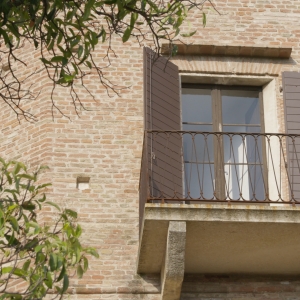Malatesta Castle in Santarcangelo
Santarcangelo Castle has an eclectic soul: It is able to satisfy the different needs of tourists, whether it is a question of organizing a business meeting, a conference or a cultural event, or it has been chosen as a holiday destination or a wedding night.
The Malatesta Rocca meets visitors and guests by welcoming them in its different rooms: the Conference Room, the Malatesta Room, the Choir Room, the Summer Room, the Landscape Tower and the Sunset Tower.
Santarcangelo Castle is open to the public and it is possible to visit it also in the company of a guide who will be able to give detailed historical explanations of this monument which is at the center of the history of the Romagna region, revealing both its small and big secrets.
Doors open to the Wonders.
The castle is closed to the public.
A bit of history
Already in the Bavarian Codex there are first reports of the existence of a 'chastrum sancti arcangeli' on Mons Iovis, towards the end of the 9th century. A fortification that was always a backdrop and an imposing yet silent spectator to intense and tormented conspiracies, such as the never-ending struggle between the Guelphs and Ghibellines and then the disputes between the seignories of the Malatesta and Montefeltro.
The
rule of the Malatesta, in particular, was decisive: the Dante-esque 'Mastin vecchio' garrisoned the castle when he became head of the Guelph side. Perhaps it is because of this latter circumstance that some scholars have also set the famous Dantean tale of Paolo and Francesca within the walls of the fortress.
It was in the 14th and 15th centuries that the Malatesta succeeded in gaining unchallenged dominion over the vast area surrounding Rimini. And it was mainly through the work of Sigismondo Pandolfo Malatesta that the fortress of Santarcangelo took on the definitive configuration that it still retains today
after completion in 1447.
The castle has, in fact, undergone a marked change in its grandeur over the centuries. Its primitive physiognomy was that of an enormous tower erected by Carlo Malatesta in 1386 to shelter himself from the attacks of his enemies. It was then Sigismondo Pandolfo who rebuilt the tower, considered to be one of the tallest in Italy, and, with the resulting material, built the current structure of the castle. Later, the Malatesta Fortress was put to the sword by Cesare Borgia in 1498.
Later, the church gave the castle in emphyteusis to various noble families, such as the Zampeschi. In 1800, the castle was then purchased by Count Baldini (remembered by a plaque in the courtyard) and the Massani family, who turned the Rocca into a farm. The
Rocca Malatestiana was then purchased by Countess Eugenia Rasponi Murat, niece of Princess Luisa Giulia Murat, daughter of Caroline Bonaparte, sister of Napoleon and the French general Joachim Murat. Having no children, Countess Eugenia Rasponi Murat left the castle to Count Spalletti, grandfather of Princess Marina Colonna di Paliano, who inherited it definitively in 1992.
Ghost and legends
Presence of five razor wells where Sigismondo Pandolfo Malatesta threw his enemies.












